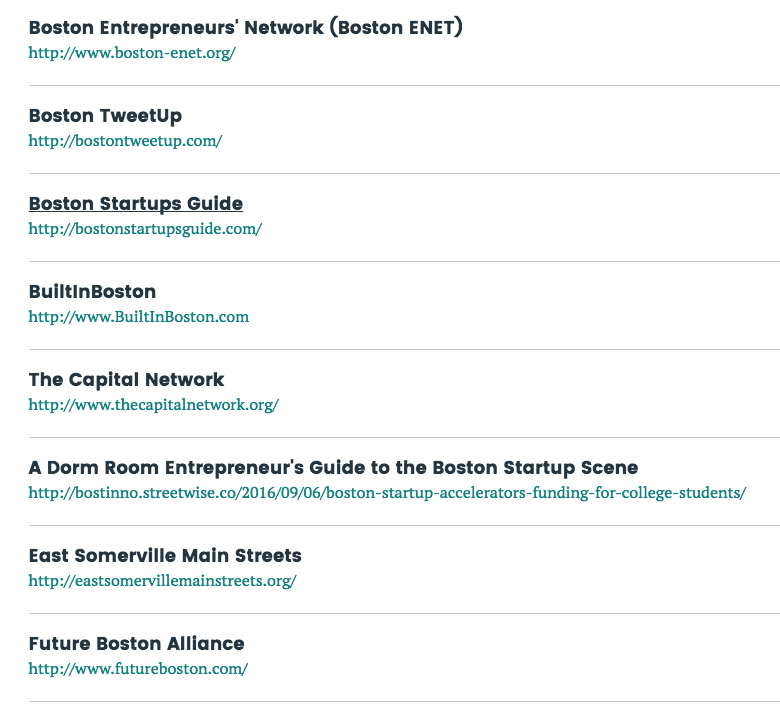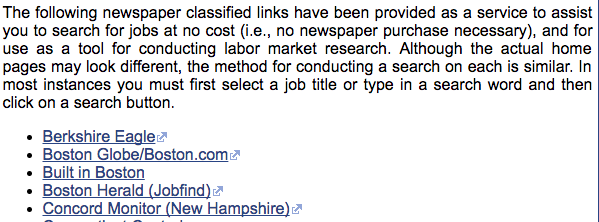by Venchito Tampon Jr | Last Updated on February 4, 2025
This is the most actionable guide to link building for local SEO.
You’ll learn here how to build backlinks for any local business on a shoestring budget.
Also, you’ll discover some advanced strategies for 2025 (and beyond) that I never shared anywhere.
Let’s get started.
1. Use Job Portals For Quick Backlink Wins
When building links for our clients, one of the first questions we ask is, “what’s the existing content asset in the client’s website we can use as USP for linker outreach?”.
This question breaks the “content mental block” often experienced when strategizing what link acquisition tactics require content to create to acquire high-quality links.
Interestingly, we’ve discovered that there are existing under-utilized pages published on client’s sites that we can use to show/provide to publishers and content creators to get them to link to the client’s page.
A great example of this content is “jobs portal”.
A “jobs portal” is a directory/curation of all job positions available in a local area.
Your brand can even curate available positions for a specific industry (e.g. “tech startup jobs in New York”).

For some local brands I’ve audited, the jobs portal is inherently the first few pages published on their sites. It serves as a content hub for their local partners, like local professional organizations looking for new team hires.
The jobs portal caters specifically to the “job seekers” linkable market with a lucrative number of links pages.
Link prospecting for this strategy is pretty much the same as how you’ll normally do it for a resource page link building or broken link building strategy, but the difference is just that you are only looking for a local linkable market – “jobs links/resources pages in Boston” for example.
You can start prospecting using Google search with any of the following search queries to collect your initial set of local link opportunities:
- “job search” “resources” “CITY”
- employment” inurl:resources “CITY”
- “job hunting” resources “CITY”
- inurl:careers “CITY”
Expand your list by reverse engineering other local job portals or job board sites.
By checking which pages link to local-relevant job board sites on this page, I collected a few more tens of local links pages.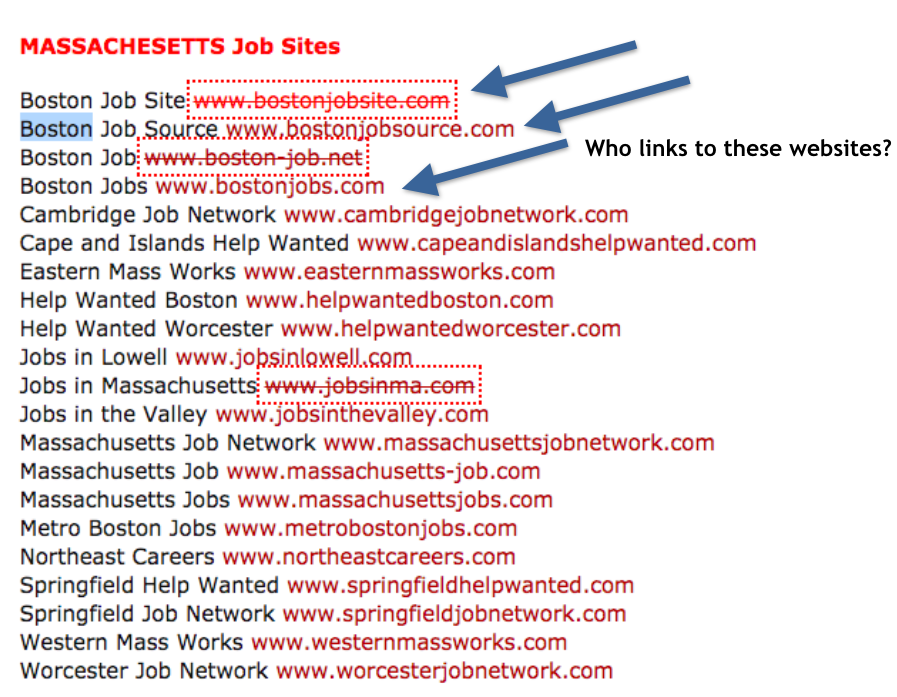
Once you have generated your list of prospects and their contact details, you can start engaging them through your outreach campaign.
Spend a few extra minutes to check if there are broken links on a prospect page.
If all links are working, simply request to be included as an additional resource on their links page.
I’ve found it helpful to add subtle changes to email copies to emphasize the local relevance of the jobs portal or any other local content pieces I’m building links to. I usually add lines for:
- The best section on the resource page to add the client’s local content
- Who is the target audience of the content?
- A few recommendations for content that serves as a social proof

With proper execution, we were able to acquire links:
2. Create Localized Visual Data
Image link building (infographic-based link building) is getting more saturated as more brands try to pick up on it. But with the right audience targeting, accurate data, and impressive design, visual data can still prove its effectiveness in getting high-value links, especially if it’s been massively promoted through different content distribution channels.
One way to get started with this approach is to find a local piece of content created by other publishers who had extensive research on a particular subject matter and transform it into a visual asset.
To give you an example, recently, we’ve been looking for a piece of content that we could well turn into an infographic.
By searching for available public data on different trusted sites, we’ve found a research study on teen dating, abuse & bullying with respondents in New York, New Jersey, and Pennsylvania.

Side note: here are a few public data sites you can source information from for your visual assets:
- https://www.data.gov/
- https://socrata.com/resources/
- https://datahub.io/
- http://data.worldbank.org/
- https://www.reddit.com/r/datasets/
We’ve checked if the public data is still relevant in the current year, as we want to get the most recent study as much as possible (the latest we consider is 2016).
One way that helped us assess the relevance and credibility of a public data piece is by looking at the version history section. For example, the research study we considered was initially published in 2012 but has been updated for 2016 (indicated in the version history section).
Then we strategize how the public data content can be turned into an infographic without cursing the target audience with knowledge.
Given that the research study has two sections: teen dating & abuse and teen bullying, we’ve decided to choose teen dating & abuse and keep the latter for future content references.
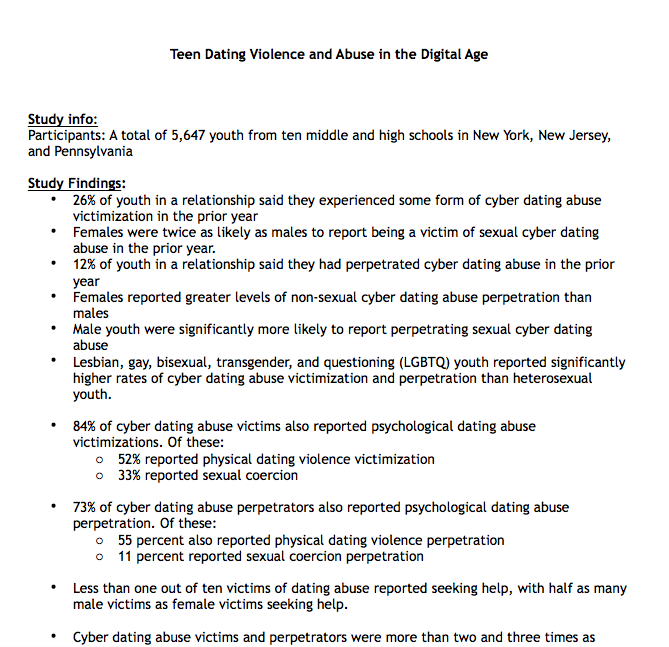
The hardest part of visual data link building is content creation.
As an agency, there are two ways to attack this: outsource to a freelancer or hire an in-house graphic designer.
We chose the latter simply because it’s time and cost-efficient.
Produced the visual data (partial image below):
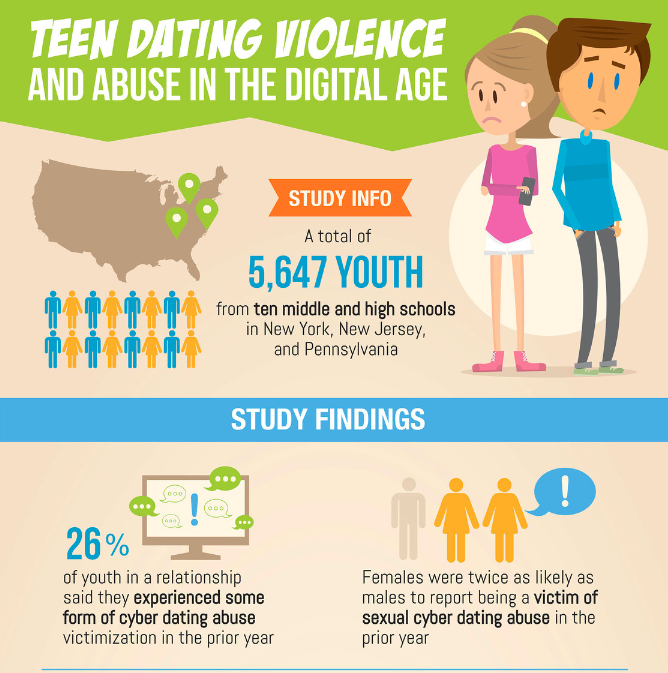
Then we spent most of our hours looking for potential link partners or content publishers interested in the content piece we produced.
We begin prospecting using the following local-centric queries in Google search:
You can also use Reverse Image Search or Tineye to find and track any local-based infographics for local bloggers and publishers who distributed these pieces on their blogs.
If you’ve been running out of prospects, you can tap other industries and look for local publishers who still cater to the targeted audience of your content.
In our case, we tapped local legal publishers with the injury/sexual harassment categories in their sections.
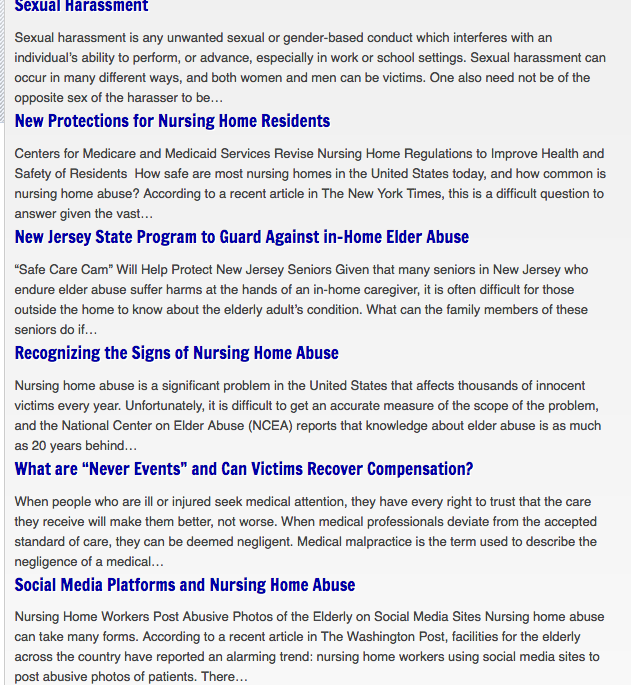
As for the outreach, make it easier for local prospects to know interesting facts about your visual data. It is best to state some numbers and your target audience to build the context, relevance, and credibility of your content piece.
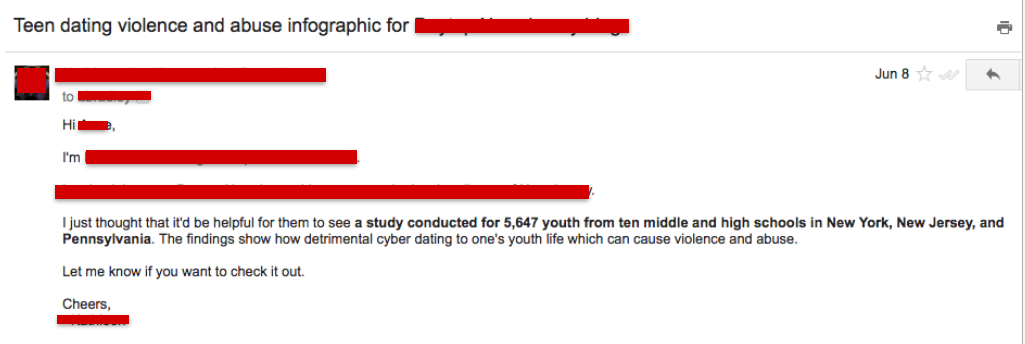
You can test the two-blogger outreach process to capture your prospects’ interests initially, then eventually send the link pointing to your visual data (or attach it to your email conversation) if they’ve positively responded to your initial pitch.
Useful Resource: The State of Backlinks for SEO in 2021: What 800+ SEOs Think About Link Building
3. Realize Opportunity In “New To An Area” Pages
For local link building, what I’ve found to be the most quantitative (high amount) in links/resource pages are those that cater to audiences relocating/living in a new area or city.
Typically, these pages provide lists of resources/references that a person new to an area would definitely find.
Here are some examples of local “new to an area” topics:
- Quality schools in [City] or finding the right schools
- Local laws in [City]
- Tourist information, local attractions, or things to do in [City]
- How to get here
- Volunteer listings in [City]
- Moving and relocation in [City]
- internet & cable
- my neighborhood
If you are marketing a brick-and-mortar business, a local attraction, a local professional organization, or a utility company (i.e. internet cable), it’s best to get your initial set of links from this type of resource page.

You can start prospecting by using “page-level” qualifier queries (which I highly recommend if you’re looking for “new to an area” topical pages) through Google search.
If you’re prospecting for “things to do in [City]” pages, here are the following search queries that you can use:
- inurl:”things to do” [City]
- intitle:”things to do” [City]
- inurl:links activities in [City]
The above approach is an alternate option to the basic link prospecting queries for resource page link building (i.e. using inurl:resources OR inurl:links “keyword”). It expands your search for link opportunities that don’t necessarily have the title tag or URL qualifiers (intitle and inurl).
The next step is to reach out to webmasters of these links pages and offer your website to be included as an additional resource on the page.
I’ve found it helpful to prepare short lines/descriptions to be added to the links page along with your link. It can help remove webmasters’ burden of thinking about what texts to add that describe your brand/website (e.g. best description of your local attraction).

If you’ve executed it properly, you’ll get a link.
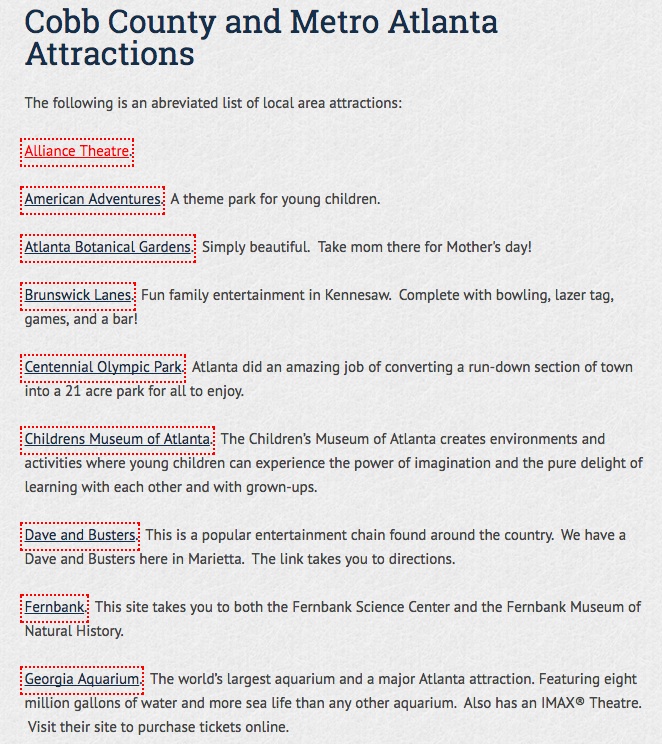
4. Get Resource Links From Summer/Off-Campus Housing [City] Pages
Summer housing/off-campus housing pages are resource lists of available housing options for students and interns in a local area.
This type of webpages can positively generate exposure to brands they’re linking out to and provide possible leads for brands’ services since the page focuses on recommending rental offerings currently available in the area.
The closest vertical that can benefit from generating high-quality links from summer housing [city] pages is real estate, particularly local apartment brands, housing, and rental services companies.
National brands with apartment rentals in different cities can also use this link acquisition technique by acquiring links from summer housing resource pages available in cities they cater offerings. The more cities they’re marketing to, the better they could take advantage of this local link building tactic.
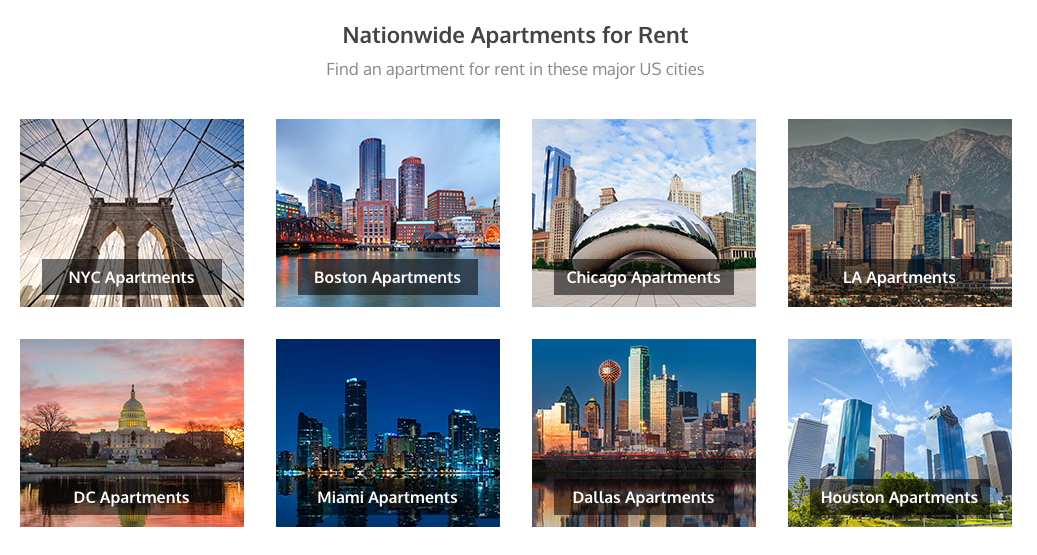
You can start this link approach by creating a list of targeted link prospects from Google search results – using any of the following search terms:
- “Off-campus” housing [city] “resources”
- “Student housing” [city] “resources”
- “Internship housing” [city] “resources”
Populate your list by checking broken domains for inbound links from summer housing pages. A simple plug to your favorite link checker tool can help quickly assess the number of unique referring domains pointing to these dead websites.
For example, this extinct site that used to be an apartment rental site has 75+ unique referring domains that include solid .edu sites links pages. A quick look at it can reveal tens of potential summer housing pages that can be added to a link list.
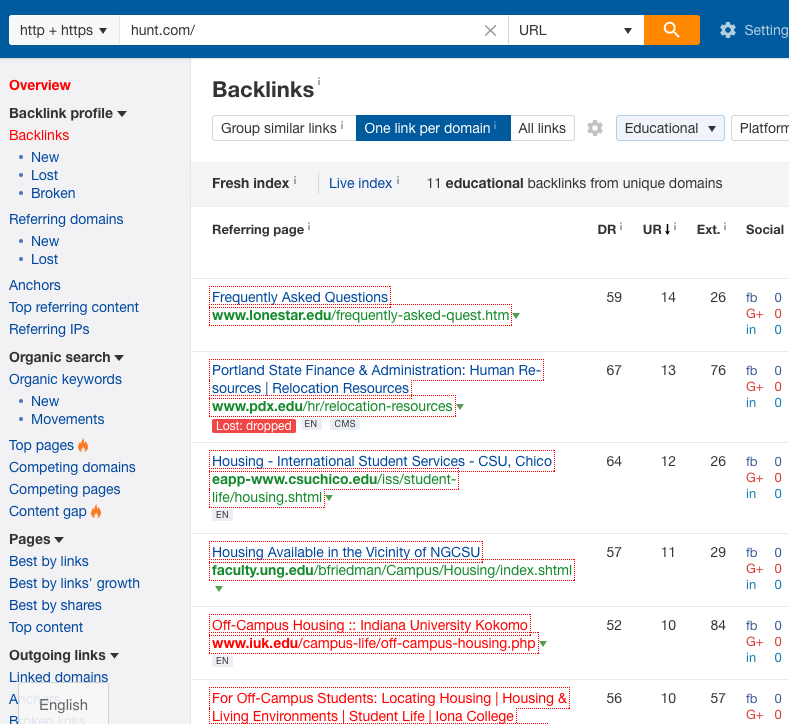
Then craft email copies you can use for your local outreach that is straightforward and easy to personalize.
Finally, acquire the link: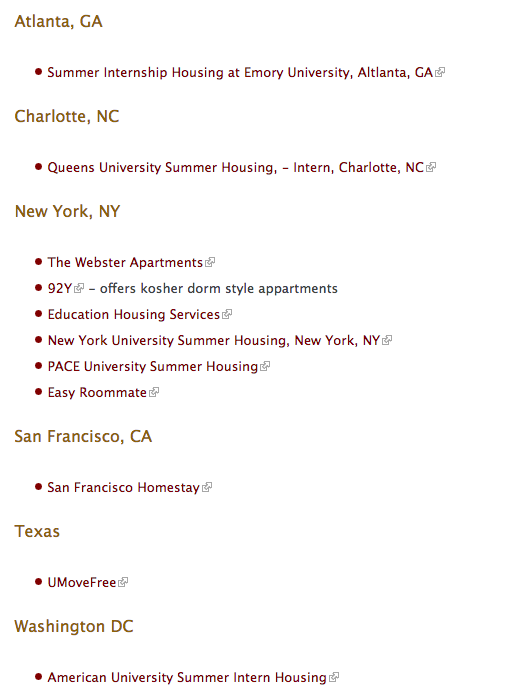
5. Serve FSQ With Local Content
Creating content that’s really hard to do and that is better than its competitors is definitely one of the best ways to stand out as an authority publisher in the industry and acquire high-quality in-content links from other content publishers on the web.
In addition, ensuring that the content piece has well-served its audience by providing their needs through the useful information on the page can increase the chances of building and earning backlinks from highly relevant sites.
For local content creation, here are topics that are frequently searched (FSQ or frequently search queries) by a local audience and linked to by local publishers:
- Street occupancy and moving permits
- [city] neighborhoods
- Helpful moving tips or things to do before you move
- Resources for landlords & tenants
- Homeowner resources
- Voter registration
- Address change
The main key to success in creating local content is to be succinct while being so much helpful in providing the details that the local audience needs.
Coming up with a guide that sums up all of the items mentioned above for people looking for direct information is an extremely useful content asset with a high chance of earning links from local content creators.
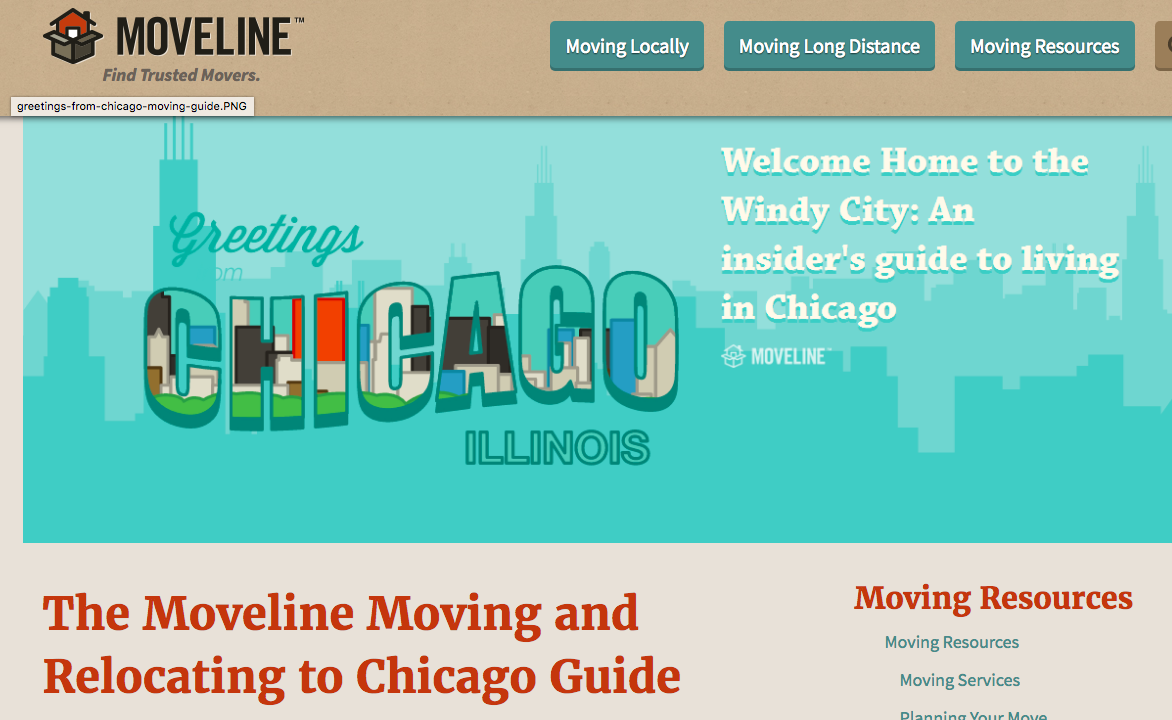
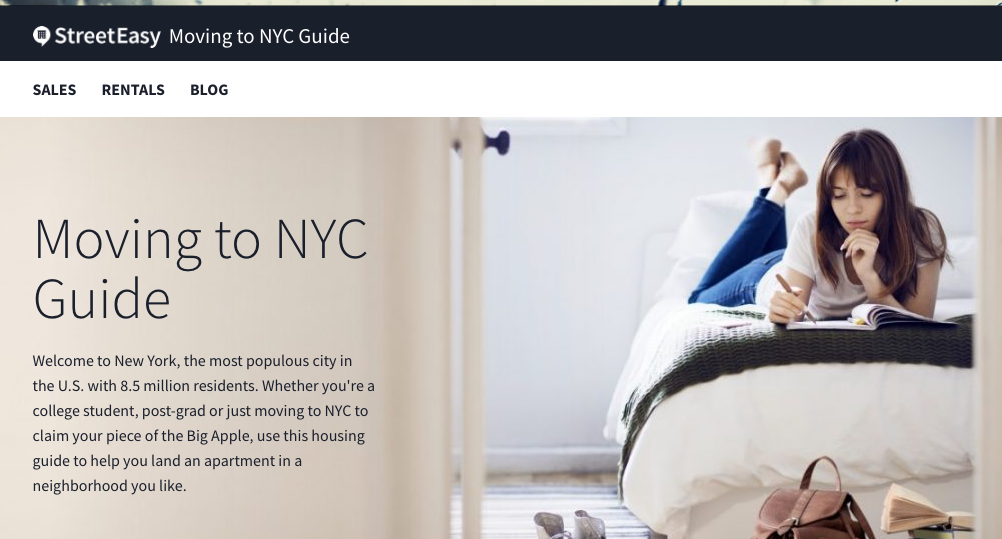
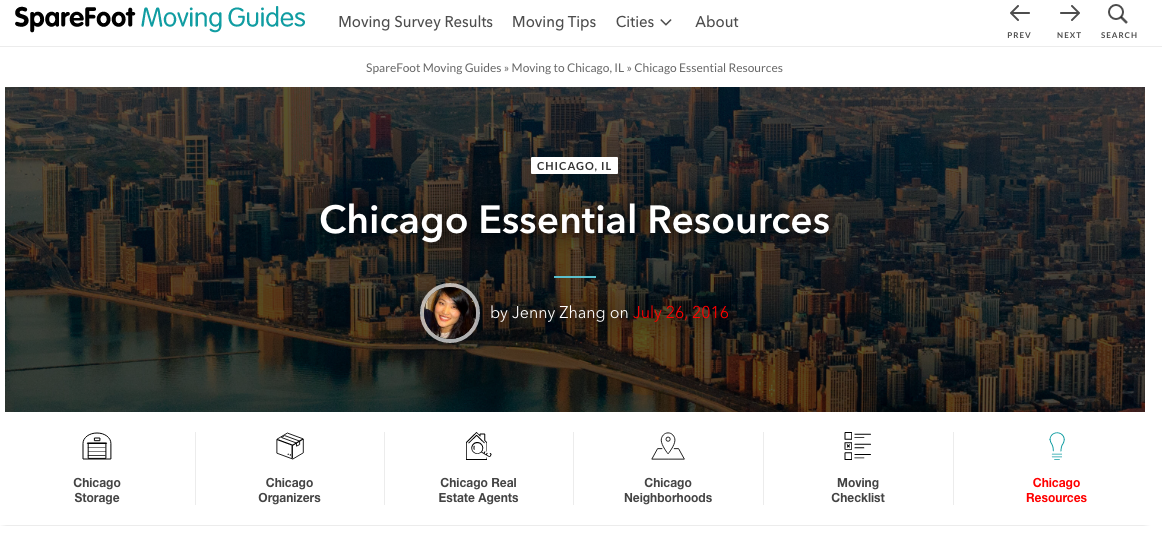
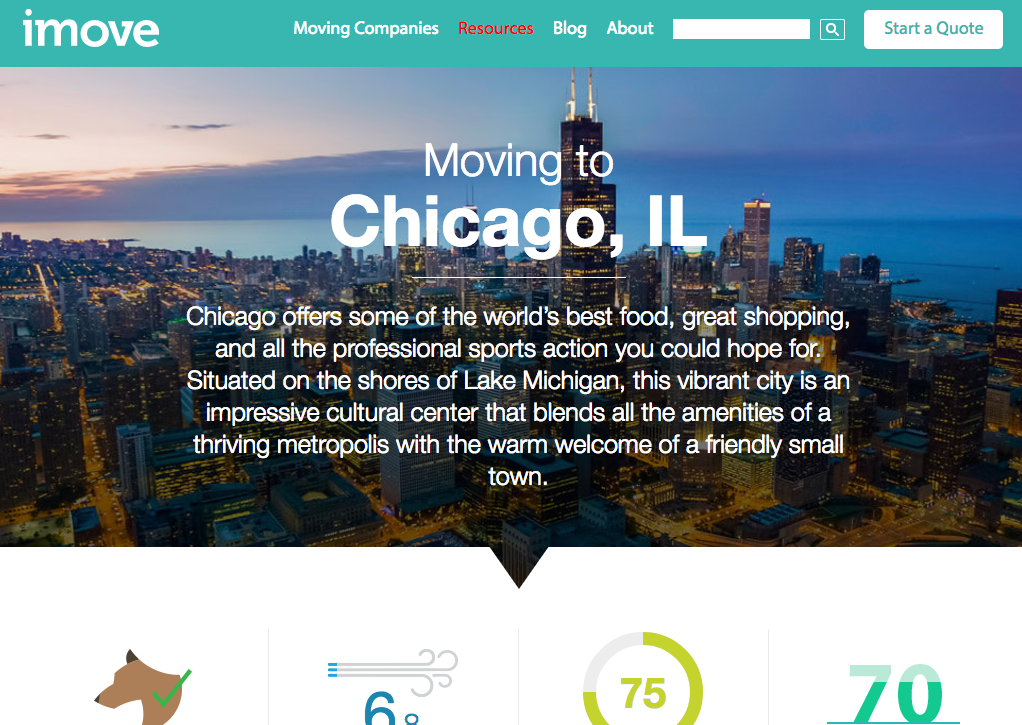
6. Seed Answers For Long Tail Online Discussions
Conversation marketing is a highly effective brand-building tool for local business owners, marketers, and an agency that markets local clients who don’t have a huge budget to spend building a strong brand presence online.
While it’s time-consuming, the amount of effort put into value-added conversations can invaluably bring momentum and exponential growth of links and drive referral traffic and potential leads for the business.
One of the best ways to start this approach is by joining online communities where your local target audience participates and looking for direct information.
For example, if you’re promoting a local attraction site, answering questions on StreetAdvisor can be an initial jump to your conversation marketing efforts.
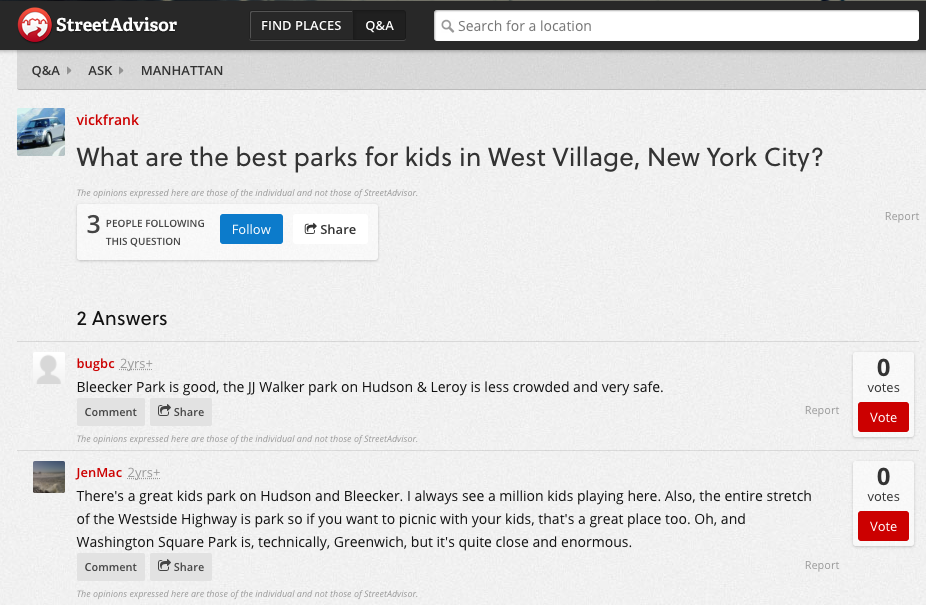
Below are some ways that you can do to leverage and scale conversation marketing for your local business:
- Do Google searches for direct questions that people are seeking to find local businesses and attractions (e.g. best [product/service] in [city/area]) and spot-on local and niche-specific forums that are currently ranking in the first two or three pages in search results – these online pages still receive a few tens/hundreds of organic traffic and may bring valuable traffic to your website.
- Choose an in-house team member with a strong knowledge of the product/service you’re offering and let him/her spend 20 to 30 minutes daily participating in local online discussions.
7. Promote Your Local Content Using Reddit
Reddit is a community news aggregator site that has its own ranking algorithm to decide which referring link deserves to be placed on the front page for a specific subreddit.
If you’re launching local content that contains a compelling story/data and design-driven images, such as infographics, then Reddit is a place that you can utilize to put more eyeballs on your content (increasing the amount of traffic you’re getting).
You can start by identifying specific subreddits relevant to your local brand. Do a Google search for site:reddit.com “keyword” OR “city,” manually check each subreddit and see if they cater to the audience with the same demographics you’re targeting.
Create a list of relevant subreddits and their current number of subscribers and online users (photo credit: Siegemedia).

It is best to take a few minutes to check referring links placed on the front page of each subreddit to assess content types (images/videos/data) that best resonate with the subreddit audience. You can add a column for Notes or Remarks in your spreadsheet to mark content formats/types.
Once you have the Reddit data to base your content upon, you can produce niche-specific content pieces that are context fit to those local subreddits.
You may want to check out this comprehensive post on creating content by building traffic sources backward from Reddit.
The next step is to customize social buttons on your content by adding a Reddit button, for example, to make it easier for Reddit users to upvote your content.
Another approach that you can make to increase the likelihood of ranking your story on the front Reddit pages is by reaching out to like-minded individuals in your industry or sharing your subreddit link with an online group of marketers to get more upvotes for your client’s content piece.
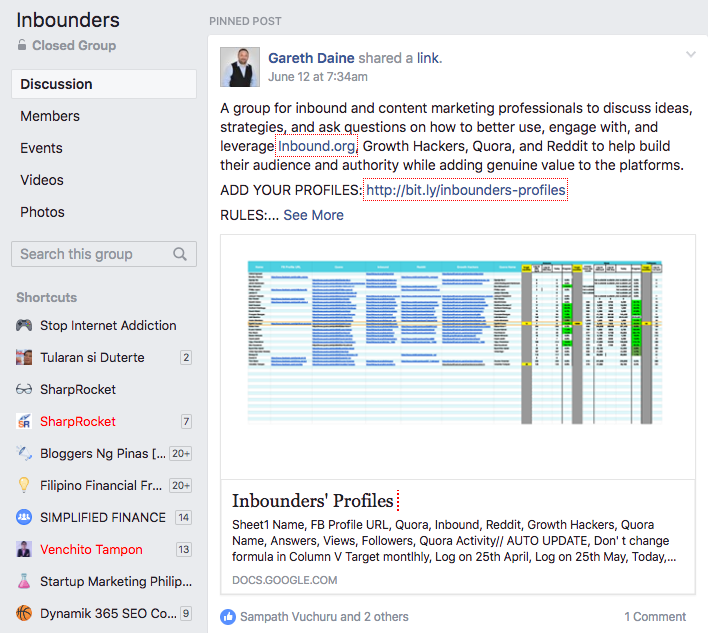
8. Use Affinity Categories For Local Sponsorships
Sponsorships are big in local SEO.
It’s nothing new.
But what makes local sponsorships successful?
Answer: proper targeting of audience.
I’m not referring to types of entities: car clubs, event organizers, town clubs, charities, and forums.
But I’m referring to your:
Potential customers.
Most local sponsorships target any local audience but not those who purchase their offerings — products/ or services.
One way to know the right market segment for local sponsorships is:
By identifying affinity categories.
Affinity categories are users likely to be ready to purchase your products or services in the specified categories.
You can find these categories in Google Analytics:
Audience > Interests > Affinity Categories
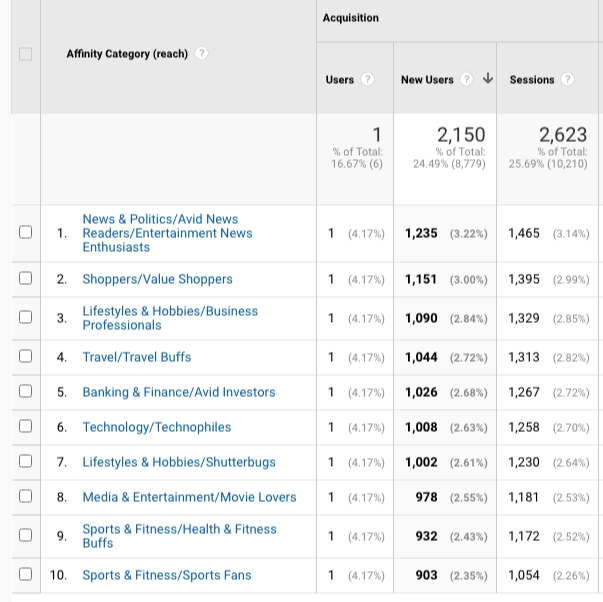
These are specified categories your potential customers are also interested in.
You’re not just getting any sponsorship link from a local website.
But you benefit from directly putting your local sponsorship to potential customers.
Pro Tip: Zipsprout has reliable link building services that directly target local sponsorships.
9. Publish Review-Type Guest Posts For Local Vendors
Guest posts are everywhere.
But instead of doing it the traditional way for local link building.
Why not try this one?
Modified shoulder guest post.
You may not be familiar with this, but it’s so simple.
Here’s the process:
Identify local vendors.
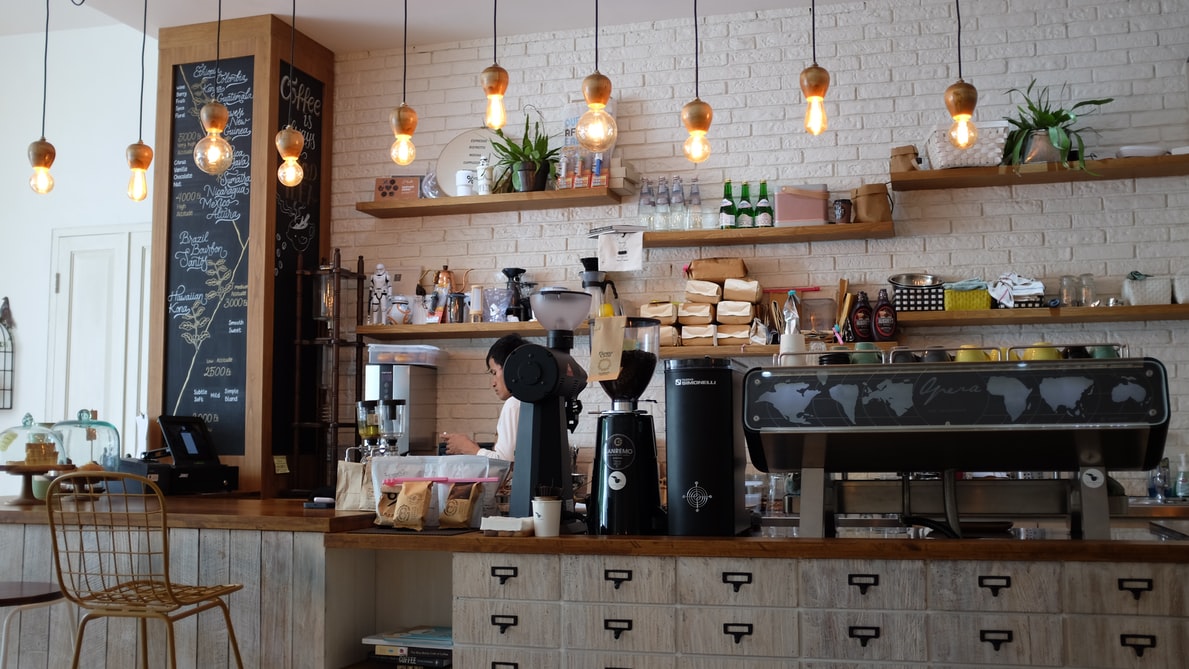
You may partner with these brands as part of your operations and marketing.
In other words, you’ve used their products or services to grow your business.
Pitch to them, not guest posts.
But a case study or a review.
The first section of the article shares about your brand — a topic, and you include the link back to your website.
Then in the second part, you showcase how that local vendor has helped grow your business.
Simple.
10. Build Vendor Partner Links
Your vendor partners are the best sources of links.
Why?
Because they know you, they’re likely to make your requests. And that includes — links.
So think about who is your vendor partners.
If you run a restaurant, you may source bread from a local bakery, or your ice cream could come from a homemade mom-and-pop shop.

Have a list of all products you sell as a brand. Then check your vendor partners for each food (for example).
Then see if they have local stores.
Do eCommerce link building by going through their “vendors list” pages.
Reach out to them and ask for links.
11. Get Low Hanging Fruits From Competitors
Competitor link analysis is nothing new.
You check who links to your competitors. Make a list of them and try to get backlinks from those pages.
In local link building, you start your search with your target keywords in Google Maps and organic search.
Then, it’s time to discover some low-hanging fruits.
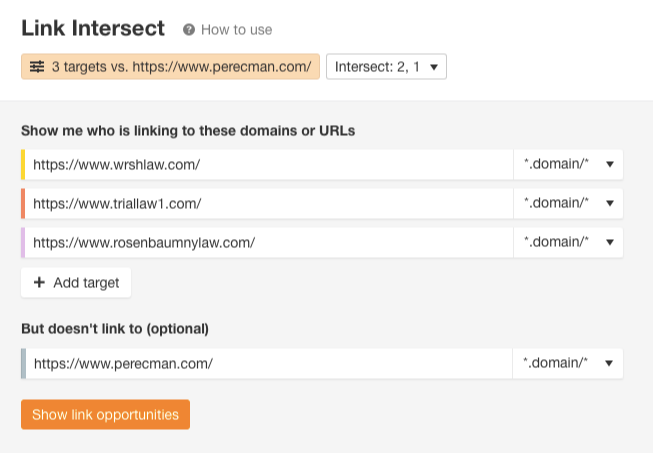
Put in your competitors’ domains. And include your website as well — but it doesn’t link to you.
You’ll now see a list of websites that link to your competitor but not your site.
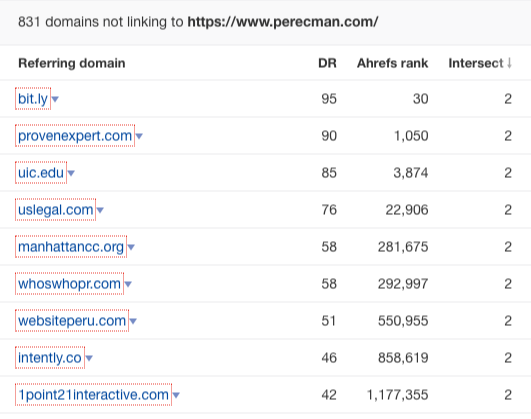
Another good thing here:
You’ll find link opportunities that are linked to a 404 page.
What you could do here is to create a better piece of content.
And reach out to all websites that linked to the broken page.
One more creative thing to do:
Get information on what link building tactics your competitors are doing.
This opens up new ideas and backlink opportunities for your local business.
12. Offer Free Content To Local Business Groups
Guest posting is nothing new in SEO.
The typical approach to prospecting industry blogs is through Google search.
Use advanced search operators (i.g. inurl) plus topic. Then you’ll see possible websites for content.
But what if you almost run out of guest post targets?
What is an alternative way to find new niche blogs?
A NEW guest post prospecting strategy:
Facebook groups.
Not just generic Facebook groups that explicitly buy/sell or accept guest posts.
But I’m referring to local Facebook groups.
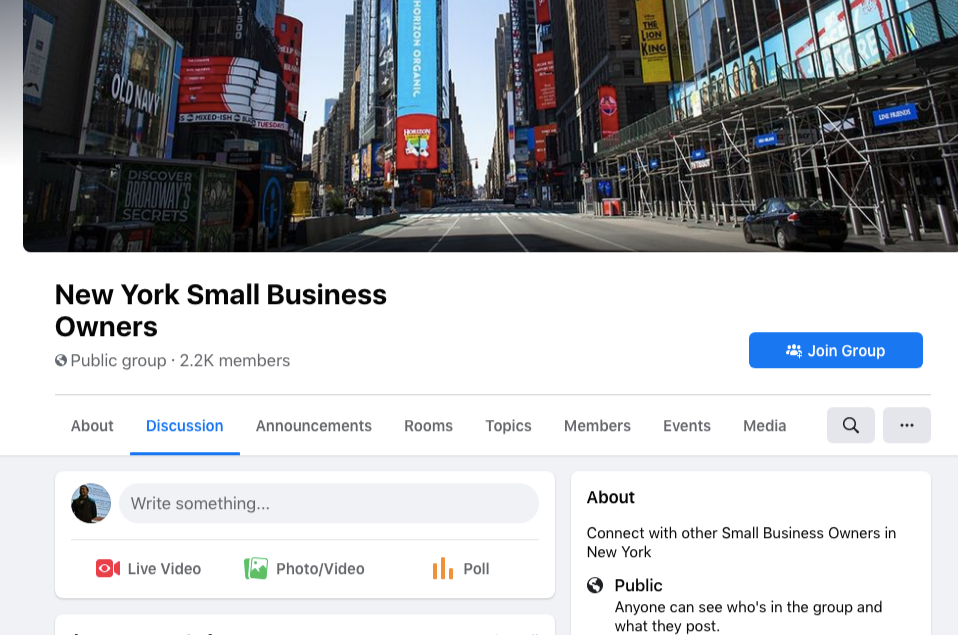
One way to get guest post prospects is to offer an exclusive service to any content writer or SEO person of a local business.
By posting on specific local business groups, you open an opportunity for anyone interested in free content in their niche.
You can start with specific niche local businesses to make your content offer appeal to members of the group.
Then once you get comments and personal messages from local business content creators, you can check the quality of the blogs.
See if it passes your blog standards. Then, write and publish an article to their blogs with editorial links.
13. Pitch Statistics Content To Local and Regional Publishers
Getting attention from local media isn’t that difficult.
Create content with a story appealing to local publishers, and you pick up great backlinks.
How can you do that?
Think of statistics content.
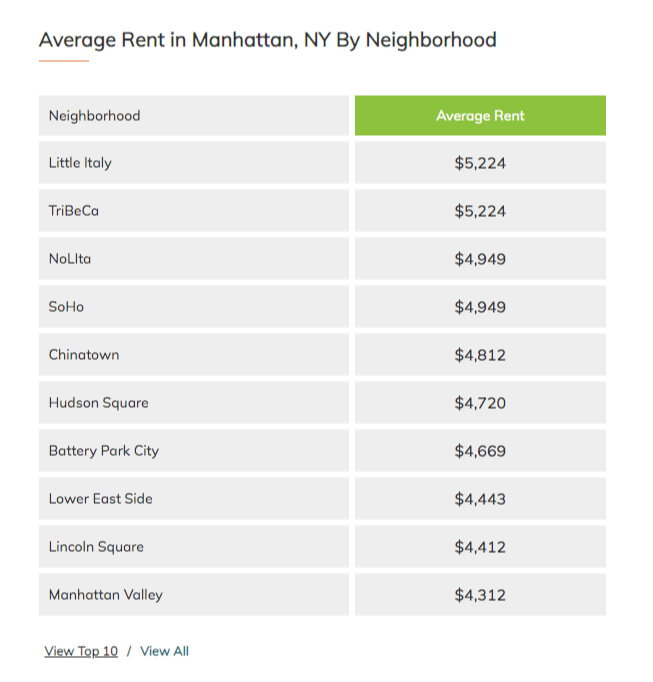
Local publishers often cite this type of content as they have information not usually found elsewhere.
Especially if points and stories are interesting or unique.
One angle you can look at is state-by-state local data.
For example, “During Covid, Rental Rates in X States were % more expensive than in Y States”.
While you can pitch this content directly to national publishers, pack some data points for local media attention.
14. Get Strategy Inspiration From Other Markets
Running out of link prospects is normal.
It often happens for local link-building campaigns where only a few websites are discovered in a specific city.
How do you come up with new targets for links?
The answer:
Outside your market, take the time to look at any other markets.
Maybe, you’ve been thinking:
What sense would it make to see your websites from different marketers when they don’t work directly with your website?
The answer is pretty simple:
You get inspiration for new link building ideas.
So if you’re in a smaller metro area, try to find other similar businesses from a large metro — to see what’s working for them.
If you’re in a large metro area, analyze backlink profiles from other larger metro areas.
You can also explore other niches, not just local businesses from other metro areas.
Let’s say you’re building backlinks for attorneys. Maybe you can see what’s working for other industries like pest control.
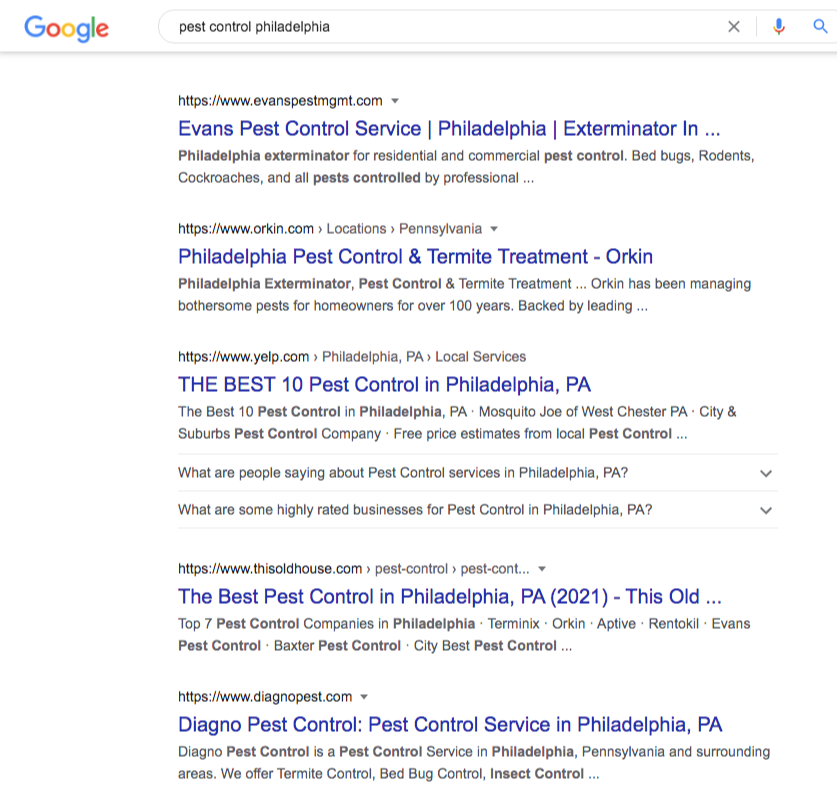
One tactic in a niche can be used differently in your local business niche.
If everyone in the legal market is doing scholarship link building, you won’t see it being effective if it’s adopted by many, including your competition.
When you discover a link building technique that’s not being abused yet by many…
You stay ahead of the competition.
Different markets have different search landscapes, so every backlink profile from ranking websites opens up other link building techniques.
15. Build Backlinks From Alumni Directories
One common type of local backlink is alumni links.
They are easy to spot and acquire for your local business.
How?
You start by looking for local schools.
Then see if they have alumni directory pages with links.
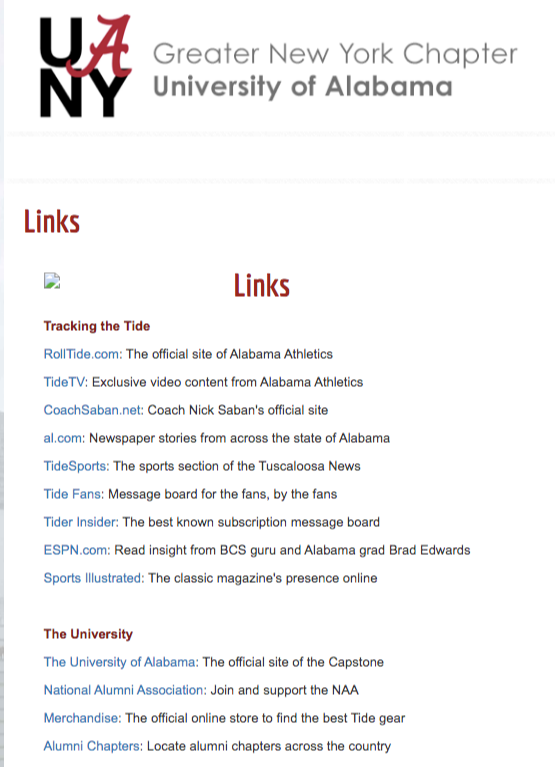
From there, you use either two of these creative ways:
Provide discounts to community members to get links from their sites’ member benefits page.
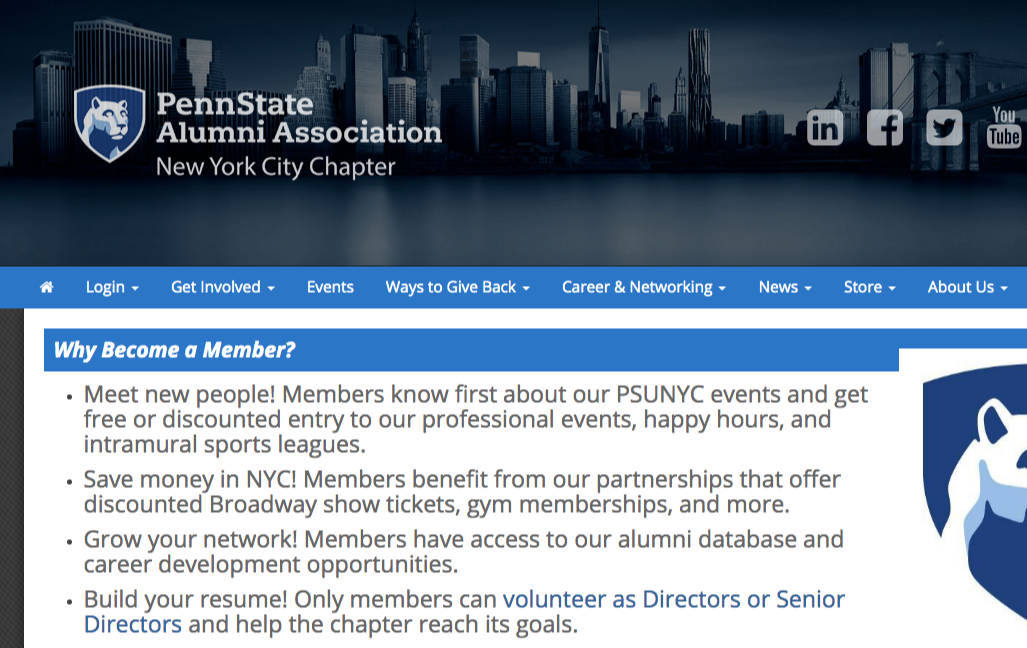
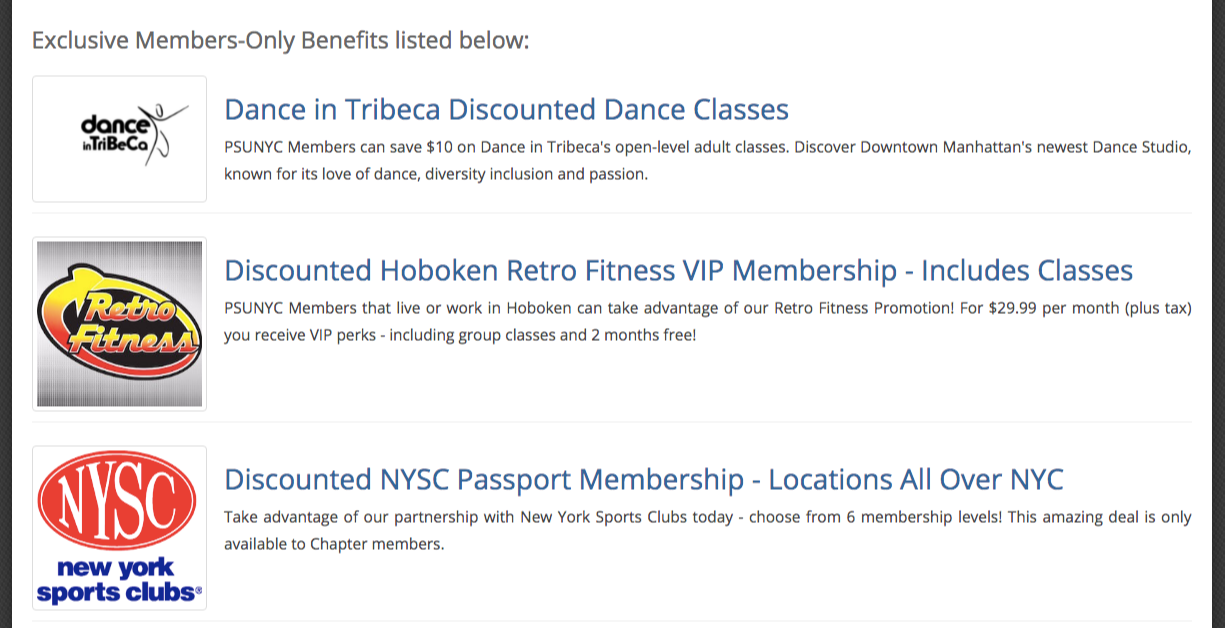
Or offer a free event space for org meetings.
If you’re an eCommerce, the first one perfectly works.
If you have extra office space (or an events hall), the second idea gives you links.
16. Acquire Gov Links Using the “Bait and Switch Strategy”
Gov links aren’t easy to acquire.
Especially for local businesses, you’ll have a competitive advantage if you can get those authority links.
Bait and switch strategy.
This is a budgeted local link building campaign to land gov links.
Here is a seven-step process to execute this creative link building strategy.
Step 1: Find 30 to 50 local councils.
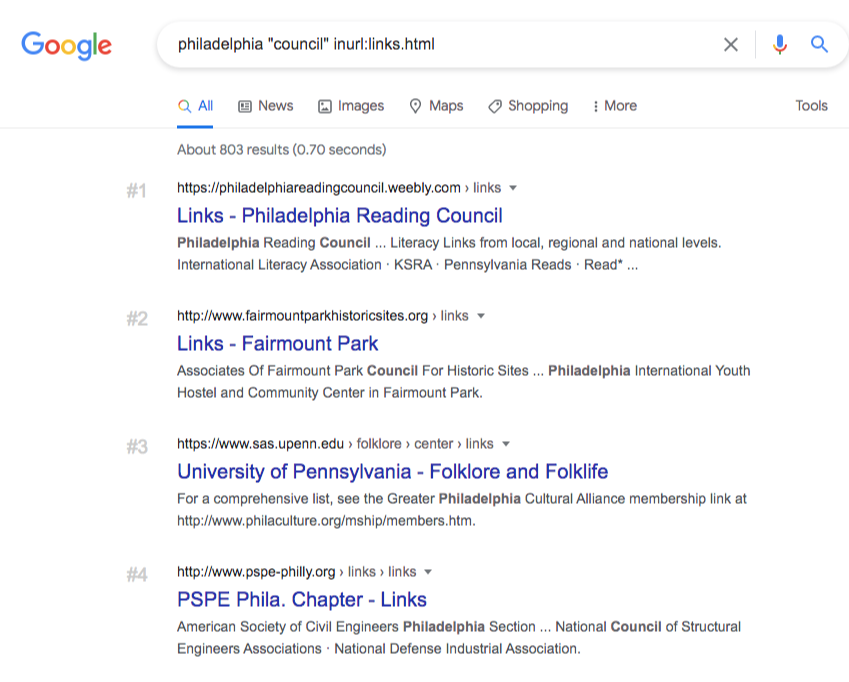
Step 2: Think about what to offer to council members. It could be a yoga class or giving away gym equipment.
Step 3: Purchase and create a .org domain. Then create a website based on your offer. For example, make a community yoga class website with a council finder if it’s a yoga class. It has no commercial intent but purely includes community information.
Step 4: Create a landing page related to the value offer (e.g., a yoga class landing page on your website).
Step 5: Reach out to all local councils and other websites to promote your new .org site.
Step 6: Create a landing page related to the value offer (e.g., a yoga class landing page on your website).
Step 7: Redirect the .org to your landing page with links to your money pages.
Win.
17. Find Local Businesses That Feature Non-Competing Brands
A strategic partnership is an excellent way to think about local link building.
There are great link opportunities when two or more non-competing brands collaborate.
For example, if you’re doing SEO for a photography website, you can find ways to get featured on wedding and event organizer sites.
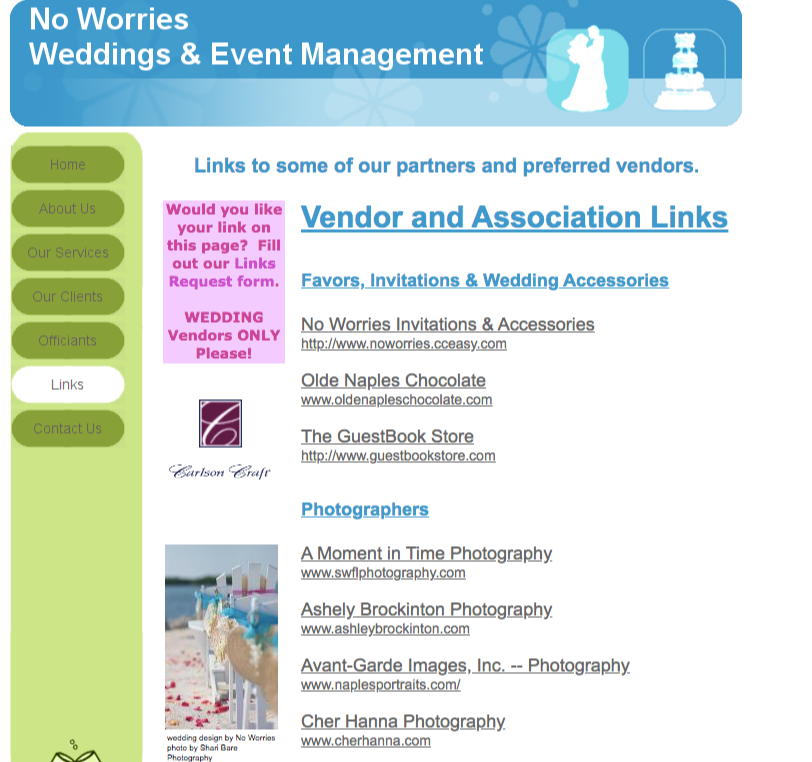
It may be from their blog section or their page listing local partner brands.
If you’re a wedding organizer, one of the best links you might get is from wedding photography sites. They might feature weddings shot at their venue.
Think of your brand.
Identify your non-competing brands.
Reach out and ask to get featured on specific pages or articles.
18. Find Local Government Programs For Certifications
Certifications help build up the credibility of an individual or business.
But did you know it’s also an excellent way to earn good local links?
Here is how to get started with this:
Find resources or programs your business needs to enroll in or get certified in.
If you’ve been certified in a few places, check those certification websites and see if they linked to people or businesses they are certified in.
Invest your resources in these certification programs for additional credibility or brand exposure, especially if your local business needs them.
19. Offer Unique Testimonials To Local Businesses
One of the best social proofs is testimonials.
If a customer gives you a testimonial in written or video format, it increases the perceived value of your products/services.
Potential customers will likely see the results from using your offer.
Think testimonials not only for conversions but also for local backlinks.
Local businesses won’t ignore an honest testimonial from a customer.
Significantly if it adds proof of results for potential customers.
So, how can you use testimonials for link building?
Step 1: Find local vendors your local business/client uses, likes, and shares.
Step 2: Offer a long-form testimonial on their website. It includes how the local vendor helped your local business.
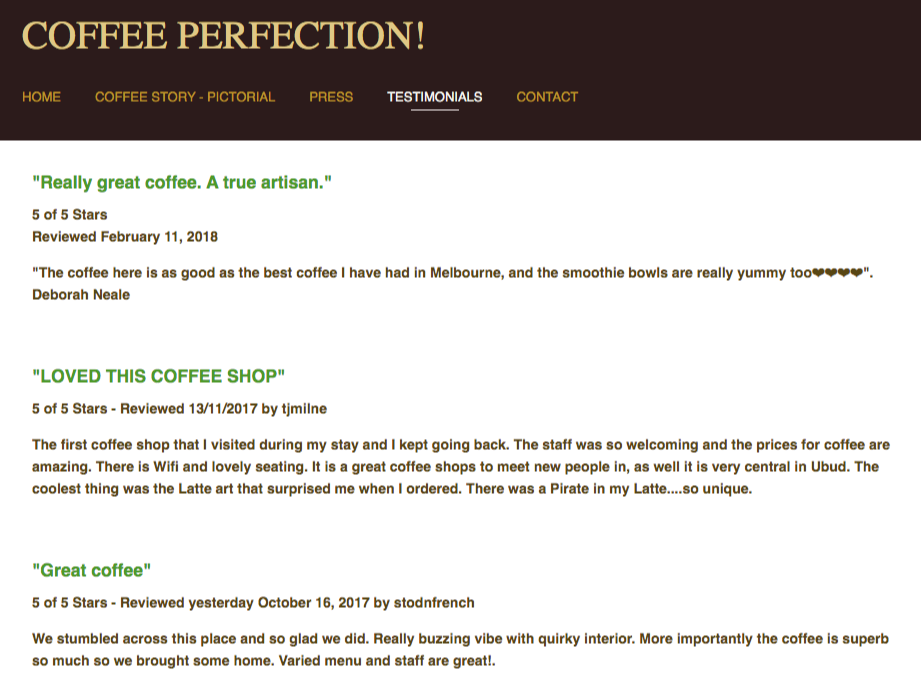
Pro tip: You can format the testimonial in a basic block of HTML, so your contact person can forward it straight to the web developer to implement the changes.
Testimonial link building is helping other local businesses grow through your words.
Then links become a by-product.
20. Publish Relevant Top X City Posts With Lead Generation In Mind
You see local content in most local business blogs.
It’s for traffic — they say.
So, for example, publishing a “Top X city” article helps drive people from your target location.
Nothing bad here.
But what if you want, as a local business, not just traffic but also potential customers?
Here’s the thing:
You can get both.
Traffic and leads.
So whenever you publish local content, think of lead generation.
Will this content I will create drive traffic and potential customers to my local business?
So instead of just creating content like:
- Top 10 things you should know about in [city]
- Best [cuisine] spots in [city]
- 5 things to do in [city]
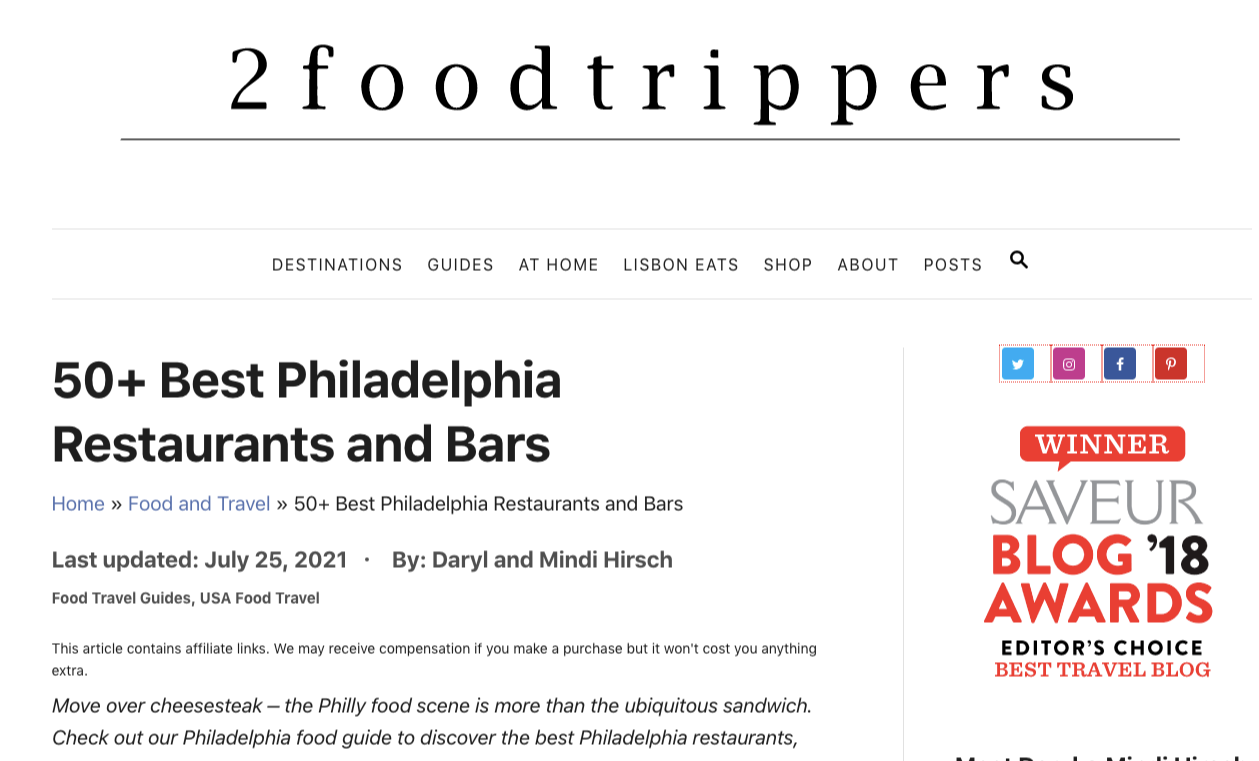
You create content that ties into your products or services.
Let’s use local vets as our example.
People interested in pet care services would usually read content like:
- 10 pet-friendly restaurants in [city]
- Pet laws in [city] you don’t know, but you should
- Dog-friendly hikes in [city] rated by a veterinarian
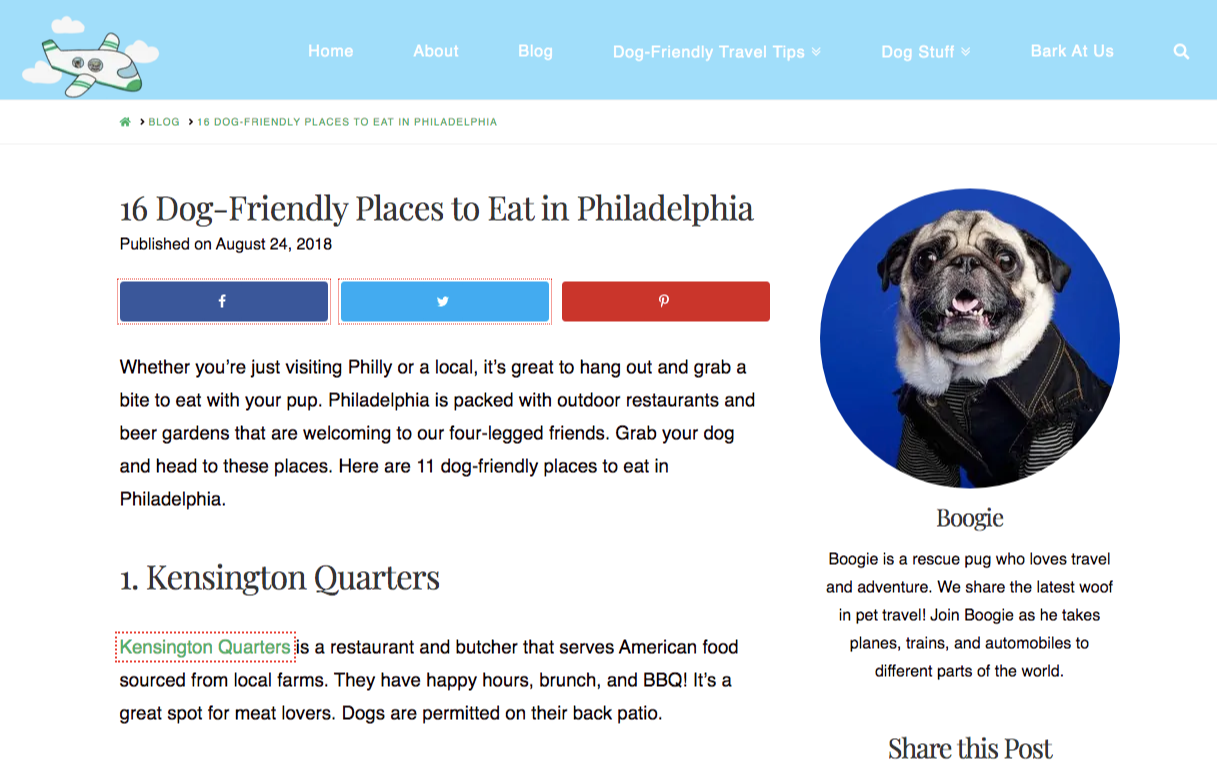
Did you get the idea?
So regardless of whether you publish it on your blog or distribute it elsewhere (i.e., guest posts), you’re also thinking about how that local content can drive conversions to your local business.
21. Discover Local HOAs & Neighborhoods Using This One Search Operator
HOA – Homeowner’s Association.
And neighborhoods.
You won’t find much of this in every city.
But consider this as one of your link building techniques.
If your local business engages physically with local town members of associations, you can benefit from this.
How can you find link opportunities from HOAs and neighborhoods?
You need to use a search function that gives you the results of a specific page.
Take a look at this search query.
“homeowners association” “florida” inurl:links.html
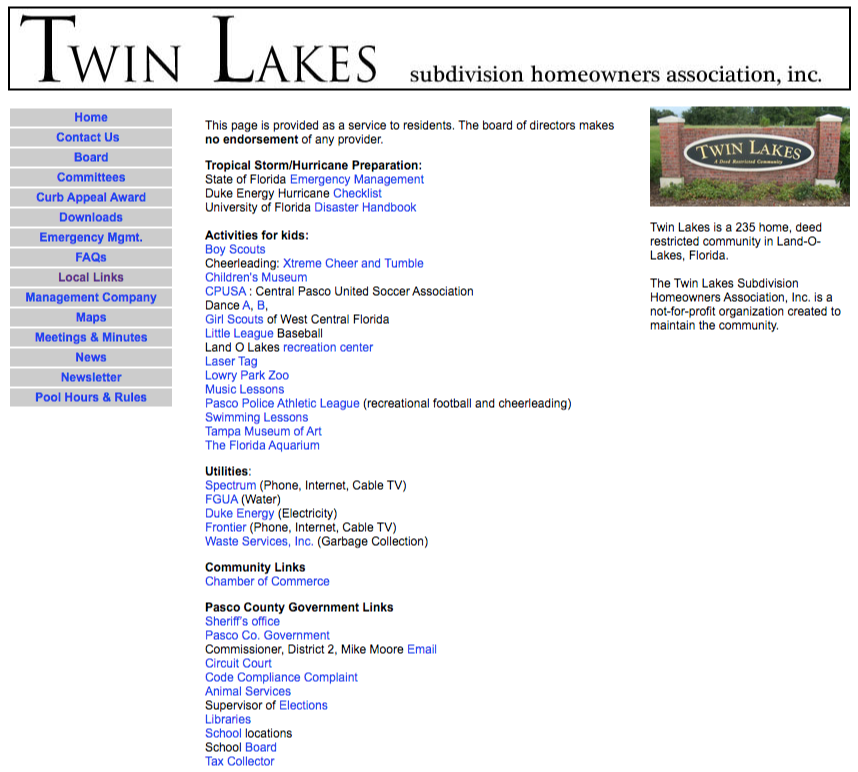
At the time of this writing, it will show links pages (in other terms, resource pages) for homeowners in New York.
You’ll have to look for links/resource pages and not just any type of page because you want to know if they have a history of linking to external resources or businesses.
So try it out for your target location.
See if there are any HOAs and neighborhood sites you can discover.
Then check if they have links/resources pages you can get listed in. Or better yet, start the search using “[city]” “homeowners” links.html
22. Build A Useful Tool For Local and Niche-Targeted Entities
One way to drive high authority links is by creating a helpful tool for your audience.
For example, Shopify created a business name generator that generated 1.9K+ in referring domains and $500K+ in traffic value.

The cost of creating tools depends on the complexity of the functions.
But what about local businesses?
Brainstorm an idea where a tool is needed.
It doesn’t have to be specific to the niche you’re in.
We are looking at the relevance of local links for this matter — as this is what we’re aiming for.
Are there any tasks or projects other businesses in your location need that you can create and generate links from it?
23. Approach Journalists With a Local Angle Of Content
Could you get journalists to cover your local business story?
The answer is yes.
But what makes journalists tick when accepting stories from businesses?
It’s the angle and hook of your stories.
If you’ve published a content piece (news, story, data, etc..) that has worked for the national press, start thinking about how you can tweak it for local media attention.
Perhaps, you can add rankings (top 5 cities or any location thereof) to your interactive world map to get that local business angle.
So if you’re looking for excellent links from local publications, always think about how to pitch local journalists with a local angle of your story, data, or any content piece.
24. Acquire Donation Links From Decent Authoritative Local Organizations
Donation isn’t a new thing in local link building.
Most local businesses with enough resources invest in donations to scale links quickly in the first months of a link building campaign.
How to start with donation link building?
Check your resources and determine your estimated budget for this link building project.
Typically, a decent donation link can cost around $500~. Some links from organizations can have lower pricing for the $200 range — but you’d have to check if it’s worth the site’s quality.
Find local organizations using two metrics:
Relevance.
The sites should be locally relevant and potentially drive potential customers to your website.
So if you’re a veterinarian in Philadelphia, try to find local pet clubs, health organizations, etc.

You can also go far from niche targeting and check from just a local standpoint.
From a recent vet example, donating to small software projects isn’t bad (as long as it’s still in Philadelphia).
The second metric is decent authority.
You can use Ahrefs’ DR (Domain Rating) to measure the website’s authority.
Try to look for sites with DR40+.
If you don’t have time for this type of link building strategy, you can hire agencies that do solely — local sponsorship marketing.
One good example is Zipsprout, founded by Garett French.
So, you can get sponsor links DIY or hire a sponsorship service like Zipsprout.
25. Use Local Linkbait Strategy To Get More Targeted Traffic
Linkbait is a type of content that gets natural links.
It benefits your local business as you create a ‘flywheel’ effect.
Where you publish a few comprehensive linkbait contents, and these handfuls of posts repeatedly hand you new backlinks over time, it becomes a natural link acquisition system for your brand.
In local link building:
There is one local linkbait strategy that you can use.
Here is how it works:
Step 1: Think of a topic that will bait local businesses to be featured on a list.
For example, if you pitch “Best 15 Coffee Shops in Philadelphia” to an owner of a local coffee shop, it’s a no-brainer the person would help with the content promotion.
Step 2: List all potential local businesses you’ll partner with for the blog post.
Step 3: Reach out to these people and let them know you are about to publish an article.
The pitch value here is that they’ll be featured in an article that will attract new leads for their local business.
Plus, it would also have more visibility for their brand and possible website links.
Pro tip: If you’ve got a solid base of social media followers, include it as part of your value pitch, “We could share the blog article across XXX followers.”
Step 4: Publish your “Top/Best X in [City]” post.
Step 5: Send the link to the blog post to your partner local businesses.
Expect local backlinks from those business blogs and other websites.
26. Write New Segment For Link Insertions
Outreach is one of the crucial phases of a link building campaign.
You connect to your target linkers with your email pitch.
That’s the reason why:
If you write an email that speaks to your linkers’ needs, you can persuade them to link to you.
How will that happen?
You encourage the outcome that you want in your initial email.
For example:
In most link insertions and outreach campaigns, you contact bloggers or publishers to include a link to your content from one of their existing articles.
This is commonly known as “niche edits.”
The way to encourage the outcome here is to write the passage with the link in the same format, existing voice, and style as the article.
This offloads the work on the part of the blogger.
The good thing here:
You help these publishers to copy-paste the new segment out of your email simply.
What’s the added value?
The easier for them to place your link somewhere on their articles, the more likely you’ll get the link.
27. Create Your Own Link Building Playbook
Here’s one thing about scaling backlinks:
You need processes to do that.
One tip here is to create your link building playbook.
This is where you’ll input all the necessary details about your link building campaign.
The playbook includes:
Backlink profile data:
Questionnaire:
Order of priorities (for link building strategies):
Procedure documents:
Reports:
Link building playbook helps you scale your link building team.
Got a new hire?
You hand it over to the playbook. Let them learn what’s inside.
The more you develop your playbook, the more you increase the efficiency and effectiveness of your campaign.
Here’s The Next Step…
Which of the 27 local link building tactics will you execute for your campaign?
Will you build backlinks from alumni directories? How about publishing relevant top X city posts to generate leads for local businesses in local link building?
Either way, let me know by leaving a comment below right now.
FAQs: Learn More About Link Building for Local SEO
1. What is link building for local SEO?
Link building for local SEO involves acquiring backlinks from websites, directories, and online platforms within a specific geographic area. These links connect your website to other trusted local sources, signaling relevance and authority to search engines. The goal is to improve your visibility in local search results and attract customers from your community or target location.
2. Why is link building important for local SEO?
Link building is crucial for local SEO because it strengthens your website’s credibility and relevance for local search terms. Search engines view backlinks from local sources as endorsements, making your website more likely to appear in searches conducted by nearby users. For example, a restaurant with backlinks from local food blogs and directories will rank higher for “best restaurants near me” searches.
3. How do local links differ from regular backlinks?
Local links come from geographically relevant sources to your business, such as local news outlets, business directories, or community websites. These links have a direct impact on your rankings in location-specific search results. Regular backlinks, while valuable, do not provide the same localized relevance and may not help improve your visibility in searches targeting your specific area.
4. What types of websites are good sources for local links?
Ideal sources for local links include:
- Local News Websites: Articles or mentions on local news platforms increase credibility and visibility.
- Business Directories: Listings on platforms like Yelp, TripAdvisor, or local directories help boost rankings.
- Community Blogs: Collaborations with bloggers focusing on your city or region can generate valuable backlinks.
- Chambers of Commerce: Membership listings and links from local business organizations establish authority.
- Nonprofits and Events: Sponsoring local charities, events, or fundraisers can lead to mentions and backlinks from their websites.
5. How do you build links for local SEO?
We use proven strategies to build high-quality local links, such as:
- Directory Submissions: Listing your business on reputable local and industry-specific directories.
- Sponsorships: Partnering with local events or organizations to earn mentions and backlinks.
- Content Marketing: Creating locally-focused content, such as guides, blogs, or videos, to attract backlinks from regional sources.
- Press Releases: Distributing press releases to local news outlets to gain coverage and links.
- Outreach: Building relationships with local bloggers, influencers, and businesses to secure partnerships or guest posts.
6. Are citations considered a part of link building?
Yes, citations are an essential aspect of link building for local SEO. Citations include your business name, address, and phone number (NAP) on other websites, such as directories or review platforms. When these citations include backlinks, they become even more valuable by driving traffic and increasing your local search authority.
7. How does link building help my Google Business Profile?
Link building enhances your Google Business Profile by boosting your website’s authority, which helps your business appear more prominently in Google’s local 3-pack (top three map results). Backlinks from trusted local sources strengthen your overall SEO and drive more traffic to both your website and Google Business listing.
8. How do backlinks improve rankings in Google Maps?
Backlinks improve Google Maps rankings by signaling to Google that your website is trustworthy and relevant for local searches. When combined with other factors, such as accurate NAP information and positive reviews, backlinks from local websites increase your chances of ranking higher in Google Maps for searches like “plumber near me” or “coffee shop in [city].”
9. How long does it take to see results from local link building?
Results from local link building typically appear within 3 to 6 months, depending on factors such as competition, the number of links built, and the strength of your current SEO. The process requires consistency and quality-focused efforts. While some improvements may be visible sooner, achieving sustained success takes time and continuous optimization.
10. What are some examples of content that attract local backlinks?
Creating localized content is a powerful way to earn backlinks from nearby sources. Examples include:
- Local Guides: Write about “Top Attractions in [City]” or “Best Restaurants in [Neighborhood].”
- Event Coverage: Create content about local festivals, fairs, or charity events.
- Customer Success Stories: Share case studies or testimonials from local customers.
- Resource Lists: Publish lists like “Top Resources for Homebuyers in [City].”
- Community Spotlights: Highlight partnerships with local businesses or nonprofits.
This type of content engages local audiences and naturally attracts backlinks from community websites and organizations.
11. Are all local backlinks beneficial for SEO?
Not all backlinks are beneficial. High-quality backlinks from trusted local sources improve your SEO and drive relevant traffic to your website. However, backlinks from spammy or low-authority sites can harm your rankings. We prioritize earning backlinks from reputable sources, ensuring that they positively impact your local SEO performance.
12. Can local link building work for service-based businesses?
Yes, local link building is especially effective for service-based businesses like plumbers, electricians, real estate agents, and healthcare providers. By earning backlinks from local directories, community blogs, and industry associations, service-based businesses can increase their visibility among nearby customers actively searching for their services.
13. Do reviews count as part of local link building?
While reviews are not backlinks, they are a critical part of local SEO. Reviews on platforms like Google, Yelp, and industry-specific sites improve local visibility and establish trust with potential customers. Positive reviews also increase the likelihood of earning backlinks when bloggers or websites mention your business.
14. Is link building for local SEO different from traditional link building?
Yes, link building for local SEO focuses on geographic relevance. The goal is to earn backlinks from sources that are local to your area or connected to your community. Traditional link building may target high-authority domains without regard for location, which may not help improve rankings for location-specific searches. Local link building ensures your business stands out in regional searches.
The Author
Venchito Tampon Jr
Venchito Tampon is a Filipino Motivational Speaker, Corporate Trainer, and a Leadership Speaker in the Philippines. He is the CEO and Co-Founder of SharpRocket, a link building agency. With a decade of experience, Venchito has a proven track record of leading hundreds of successful SEO (link builidng) campaigns across competitive industries like finance, B2B, legal, and SaaS. His expert advice as a link building expert has been featured in renowned publications such as Semrush, Ahrefs, Huffington Post and Forbes. He is also an international SEO spoken and has delivered talks in SEO Zraz, Asia Pacific Affiliate Summit in Singapore, and Search Marketing Summit in Sydney, Australia. Check out his other businesses, Hills & Valleys Cafe, Blend N Sips and Saas Pursuit.
How our LINK BUILDING AGENCY builds 250 links/mo consistently using Predictable Link Building Methodology™…
- Using a SIMPLE and PROVEN system
- Using a SCALABLE strategy
- No private blog networks
- No creepy outreach emails
